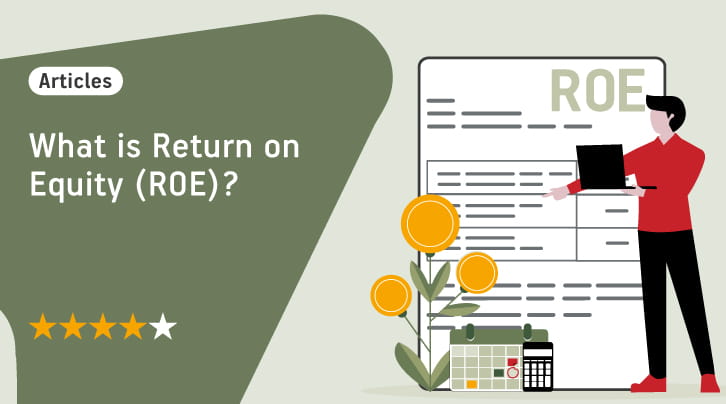Return on equity (ROE) is a crucial financial metric for assessing a company's performance and profitability. ROE is a crucial indicator that analysts, businesses, and investors use to assess how well a company uses its shareholders' equity to generate profits. This comprehensive analysis will examine every aspect of ROE, including its definition, calculation, relevance, applications, and limitations.
What Is Return on Equity (ROE)?
Return on equity, or ROE, is a financial ratio that measures a company's profitability concerning its shareholders' equity. Each Rupee that shareholders invest in equities generates a return that is measured. ROE assesses a company's ability to profit from its shareholders' investments.
Return On Equity Formula (ROE)
Here is the return on equity formula:
\[ROE = \frac{Net Income}{Shareholders' Equity}\]
Where:
Calculating Return on Equity (ROE)
Using the following imaginary example, let's analyze the roe formula calculation process:
Assume that Company ABC has shareholders' equity of INR 5,000,000 and a net income of INR 1,000,000. To determine ROE:
\[ROE = \frac{1,000,000}{5,000,000} = 0.20\]
In this example, Company ABC has a 20% ROE. Accordingly, the company makes 2 RS profits for every INR 100 that shareholders invest in equity.
What Return on Equity Tells You?
A company's financial performance and condition are essential topics covered by ROE. Here's what it can tell you::
Profitability: A business with a high ROE is profitable and generates earnings with equity. A low ROE suggests that a company may not be able to convert investments into profits successfully.
Efficiency: The ROE of a company tells us how well it manages its assets and liabilities. A higher ROE indicates better asset and resource management.
Growth Opportunities: Investors widely use the ROE to assess a company's growth prospects. A consistently high ROE could indicate the company can reinvest profits to fuel future growth.
Why is ROE Important?
A crucial indicator is return on equity for several reasons.
Investor Confidence: Investors use the ROE to evaluate a company's stock's appeal. A strong ROE can raise stock prices and instill confidence in investors.
Performance Assessment: Analysts and investors can compare the performance of multiple companies operating in the same industry using ROE. Finding leaders and strugglers in the industry is aided by this.
Management Evaluation: ROE is a helpful tool for assessing a company's management. It illustrates how management can effectively generate returns for shareholders.
Why Use the Return on Equity Metric?
ROE is a simple and useful method for assessing a company's financial performance. Here are some solid reasons for using this metric:
Simplicity: A wide spectrum of stakeholders, from individual investors to financial specialists, can use ROE because it is easy to calculate and interpret.
Comprehensive Insight: In the form of a single measure, it provides a comprehensive evaluation of a company's profitability, efficacy, and growth potential.
Evaluation: ROE enables businesses to evaluate their performance against their rivals, allowing them to identify areas for improvement.
Drawbacks of ROE
Although ROE is a useful metric, it's important to understand its limitations:
Industry Differences: Due to variations in capital structure and business methods, the ROE could not be directly comparable across industries.
Manipulation: Companies might use financial engineering techniques like share buybacks to artificially lower the numerator (shareholders' equity) to boost ROE.
Short-Term Focus: ROE's emphasis on short-term profitability may differ from a company's long-term strategic goals.
How to Use Return on Equity?
To make smart choices based on ROE, take into account the following steps:
Comparative Analysis: To understand its performance, compare a firm's ROE against its competitors and the industry averages.
Historical Trends: Examine a company's ROE over time to identify trends. A consistently rising or dropping ROE could indicate important developments.
Underlying Issues: Identify the root causes if ROE has significantly changed. Is it the outcome of changed capital structures, increased profitability, or financial maneuvers?
Limitations of Return on Equity
It's crucial to be mindful of the following limitations when interpreting the ROE:
Lack of Context: ROE cannot fully provide a company's financial status. It should be considered alongside other financial factors.
Timeline: ROE emphasizes quick results. Long-term investors must evaluate a company's strategy beyond its near-term profitability.
Example of Return on Equity
Let's look at an example to illustrate the importance of ROE in the real world.
Compare two tech-related companies, Company X and Company Y. Company X's ROE is 15%, compared to Company Y's 25%.
Further research reveals that Company X's conservative approach, which prioritizes stability and dividends, is the cause of its lower ROE. In contrast, Company Y has a higher ROE since it devotes a significant portion of its income to R&D to attain rapid expansion.
Your investment choices in this scenario will depend on your risk tolerance and investing goals. While Company Y might attract individuals seeking greater growth potential, Company X would be a safer choice for income-focused investors.
In conclusion, return on equity is a versatile indicator that provides essential information about a company's financial performance. Using wisely alongside other financial indicators can help investors and businesses make informed decisions about investments, strategy, and growth. It's essential to comprehend its limitations and consider the broader financial picture while making well-informed decisions.
Mutual Fund investments are subject to market risks, read all scheme related documents carefully.





 1800-270-7000
1800-270-7000




